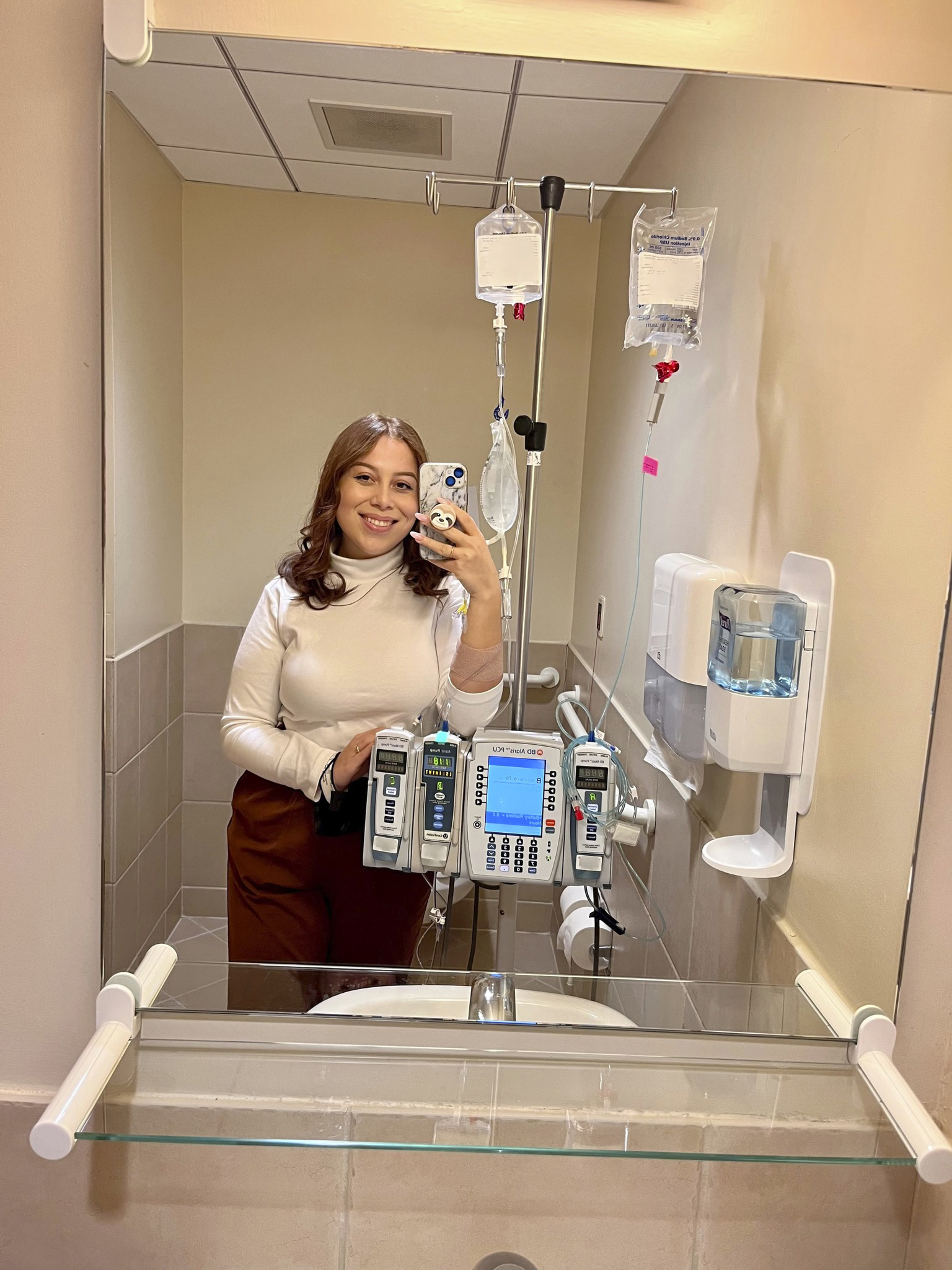Woman diagnosed with MS at age 24 puts spotlight on underrepresentation of Hispanics
Angelina Cubero said it took her a decade to get diagnosed with MS.
Angelina Cubero said she spent nearly a decade of her life going to doctors, trying to find out why she experienced migraines, brain fog numbness and pain in her legs, and other unexplained symptoms.
"I would go to the doctor, I would go to the ER, I would go to urgent cares, I would go to my primary doctor, I'd go to a specialist, another specialist, and I wasn't really getting any answers," Cubero, 27, told "Good Morning America." "They would say, 'You look fine. You don't look sick. All your tests seemed normal to me.' ... The only reason they told me was anxiety."
Cubero, who lives in Jersey City, New Jersey, said it was only three years ago, in 2020, that she underwent a second brain magnetic resonance imaging scan, or MRI, where doctors discovered multiple lesions, or plaques, in her brain.
The discovery led to a diagnosis of a disease Cubero said she had never heard of, multiple sclerosis.
"I'd never heard of MS," Cubero said. "I had to do my own research to figure out what is MS, and that was scary."

Multiple sclerosis is a neurological disease in which the immune cells in the body body injure myelin, the tissue that surrounds nerves, including those in the brain and spinal cord, according to the National Institutes of Health. It is a chronic disease, with no known cause and no known cure.
It is also a disease that can be unpredictable, causing differing symptoms with variable timing and frequency, from fatigue, numbness or tingling, weakness, dizziness and vertigo to, in the most severe cases, rendering a person unable to write, speak or walk, according to the NIH. Even individually, MS symptoms can vary, ranging from mild to extreme pain during a flare-up of the disease.
Cubero said that as a Hispanic woman who was 24 years old when she was diagnosed with MS, she struggled to find anyone who looked like her talking about the disease.
"There were so many questions I had, and it was really hard to find those answers," Cubero said. "I didn't really find much information on how it affects the Hispanic community ... and I didn't know how it affected young people."
Cubero was a senior in college when she was diagnosed, and said she decided to write her senior thesis on either MS and young people or MS and Hispanics.
"I was like, 'I'll do one or the other,' and I couldn't find research for either," she said. "So that was the tricky part, not only for my project, but also for personal knowledge on how this new disease that I have affects me."
Why Hispanics have been overlooked in MS research
Though Cubero struggled to find representation after receiving her MS diagnosis, she is not alone.
Symptoms for people with MS usually first start between the ages of 20 to 40, and the disease is estimated to be three times more common in women than men, according to both the NIH and the National Multiple Sclerosis Society, a nonprofit organization focused on raising MS awareness and increasing research.

In addition, people of Hispanic or Latino descent are more likely to be diagnosed with MS at younger ages and have earlier onsets of symptoms, according to the National Multiple Sclerosis Society.
Julie Fiol, the organization's associate vice president of health care access, told "GMA" that Cubero's experience of struggling for years to get a diagnosis is not uncommon among MS patients, especially for people of color.
For far too long, MS was viewed as a disease that affected white people.
"It can be challenging for anyone to receive a diagnosis because there is no one, easy-to-access confirmatory test that says that you have MS," Fiol said. "There are several tests, like an MRI, that can be done that can help rule in and confirm a diagnosis of MS, but before even getting that, it requires someone to be connected with a physician who takes them seriously, acknowledges that their symptoms are real and can put together that the person who is sitting in front of me could potentially have MS."
She continued, "For far too long, MS was viewed as a disease that affected white people, so if you didn't fit that mold of what that clinician was expecting to see for MS, they may not have even considered MS as a possibility."
In Cubero's case, she said it was only when she found an MS specialist who is also a psychiatrist that she began to receive the treatment she needed.
"He understood what was anxiety and what was MS, and he heard me out and he said, 'No, you actually have relapsing-remitting MS. Those are MS symptoms,'" Cubero said. "That was when I finally felt validated and secure, like, OK, I can trust my doctor moving forward and we can come up with a plan that works best for me."
With relapsing-remitting MS, the most common type of the disease, symptoms occur in attacks, called a relapse or exacerbation, followed by a period of remission that may last for weeks, months or years. People with secondary-progressive MS have usually had a history of MS attacks and their symptoms and ability to function worsen over time. In the two more severe and rare forms of MS -- primary-progressive MS and progressive-relapsing MS -- people's symptoms progressively worsen from the beginning, with no remission, according to the NIH.
People of Hispanic and Latino descent often have more severe symptoms of MS, with a faster severity of disease, according to the National Multiple Sclerosis Society. In addition, optic neuritis, or swelling of the eye's optic nerve, which can impact vision, is twice more common in Hispanic people with MS.
Exactly why Hispanic patients are hit younger and more severely by MS remains to be seen because research has been so limited, according to Dr. Lilyana Amezcua, who is considered one of the pioneers in researching the impact of MS on the Hispanic and Latino communities.
"Is that all an issue of access to care and what we call social determinants of health, or are there other environmental factors and genetic predispositions that do not allow for better recovery of the disease? Those are all questions that are unanswered at this time," Amezcua said.
Amezcua, a neurologist and Multiple Sclerosis Fellowship Program Director at the University of Southern California's Keck School of Medicine, said she began studying the connection a decade ago as a practicing neurologist in Los Angeles. At the time, she said less than 1% of MS scientific literature focused on Hispanics or African-Americans.
"One of the things that I was observing was that with Hispanic patients, there was a delay of diagnosis," she said. "When I would compare them to what I would expect for white people, it was about one to three years delay of getting that diagnosis, so from there we started with our first initial studies to better understand this population."
As she began her research -- founding the Alliance for Research in Hispanic MS, a collaboration between multiple universities -- Amezcua said she and her colleagues discovered that Hispanics had been vastly underrepresented in clinical trials. When it comes to clinical trials on medications to treat MS, for example, just 7% of participants are Hispanic, according to Amezcua.
"We know probably that the drugs do work, but we don't know to the extent, particularly if the disease in [an Hispanic patient] is starting a bit more worse," she said. "What is the possibility that we're going to sort of calm [MS] down more effectively with one drug?"
Amezcua said the group is now leading a global study that is researching one specific drug targeted for Hispanic and African-American populations, which were both underrepresented in other clinical trials.
The group's research over the past decade has also shown that many of the genetic risk factors present in white people diagnosed with MS are also present in the Hispanic population, according to Amezcua.
"We're hoping to dig deeper to see if there's additional risk factors that are both genetic and environmental that could help us understand ... MS, and help not just Hispanics but everyone else," she said, adding that while there are barriers, more and more Hispanic people want to participate in MS research.
"We find that there's a high interest of wanting to participate because they're interested in understanding what does MS look like in them, What are the best treatments out there and what services are out there?"
Both Fiol and Amezcua noted that in addition to scientific research, a large part of the work being undertaken by researchers and patient organizations like the National Multiple Sclerosis Society is to educate both medical professionals and the general public about all the populations MS may impact.
In the Hispanic community, that means working to increase access to MS specialty centers and educating people about MS as a "silent disease." The education includes sharing information about the signs and symptoms of MS both so that people can get medical care earlier, and so families and caregivers understand more about the disease.
"In MS you have those symptoms that are visible, like walking with a cane, but you also have the silent symptoms and the silent symptoms can culturally be an issue," Amezcua said, noting that fatigue, for example, may be perceived as laziness to people unfamiliar with MS. "MS is not as common as, let's say diabetes and hypertension is in this population, so many of [a patient's] family members may not have heard about MS."
Fiol said a large part of her work at the National Multiple Sclerosis Society is focused on recruiting MS specialists like Amezcua, who are Hispanic.
"We know that people feel more comfortable seeking care from doctors that they feel they can trust and can relate to, and sometimes that has to do with just finding someone that looks like them," Fiol said. "And only 7% of the neurology workforce in the U.S. is Hispanic, so we have a lot of ground to cover and a lot of work to do."
Becoming a voice for Hispanic people with MS
Nearly two years after she was diagnosed with MS, Cubero said she began sharing her journey publicly on social media in hopes of raising awareness of the disease and how it can impact Hispanic people as well as young women.
"Having a diagnosis leads to treatments, which leads to a better experience," Cubero said of the importance of people knowing the signs and symptoms of MS. "I'm just grateful to have a diagnosis because it led me to an MS center, which has a lot of resources for me to improve."
Cubero also began to use her voice literally to help raise awareness. She partnered with Genentech, a pharmaceutical company that makes an MS medication, on its #MSVisibility: Breaking Barriers campaign and wrote a song about her journey in order to help educate people and make others with MS feel less alone.
"I wish I had that when I was searching for answers," said Cubero, a singer who performs under the stage name Lina Light. "It's bittersweet for me, but I'm really happy to help others because I feel like I'm going through this for a bigger purpose. It wasn't just my story, it was to help others to get through their diagnosis too and to support each other."
Cubero said she has met other "MS warriors" through the National Multiple Sclerosis Society, which last year hosted its first-ever Hispanic LatinX Experience Summit that brought people together to connect virtually with each other.
The National Multiple Sclerosis Society is now also establishing an Hispanic-Latinx Collaborative, an initiative designed to increase outreach and engagement with those communities, according to Fiol.
Throughout her years-long health journey, Cubero said she has learned to advocate for herself. It's one of the lessons she said she hopes other people take away from her story.

"I really want people to be their best advocate, to speak up," she said. "I know that it can be intimidating. I know that it can be hard, but you have to speak up. You deserve the best care."







